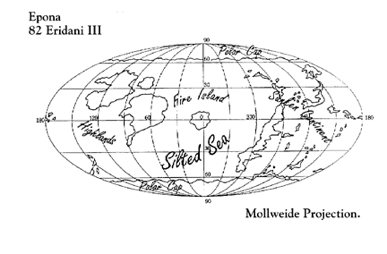
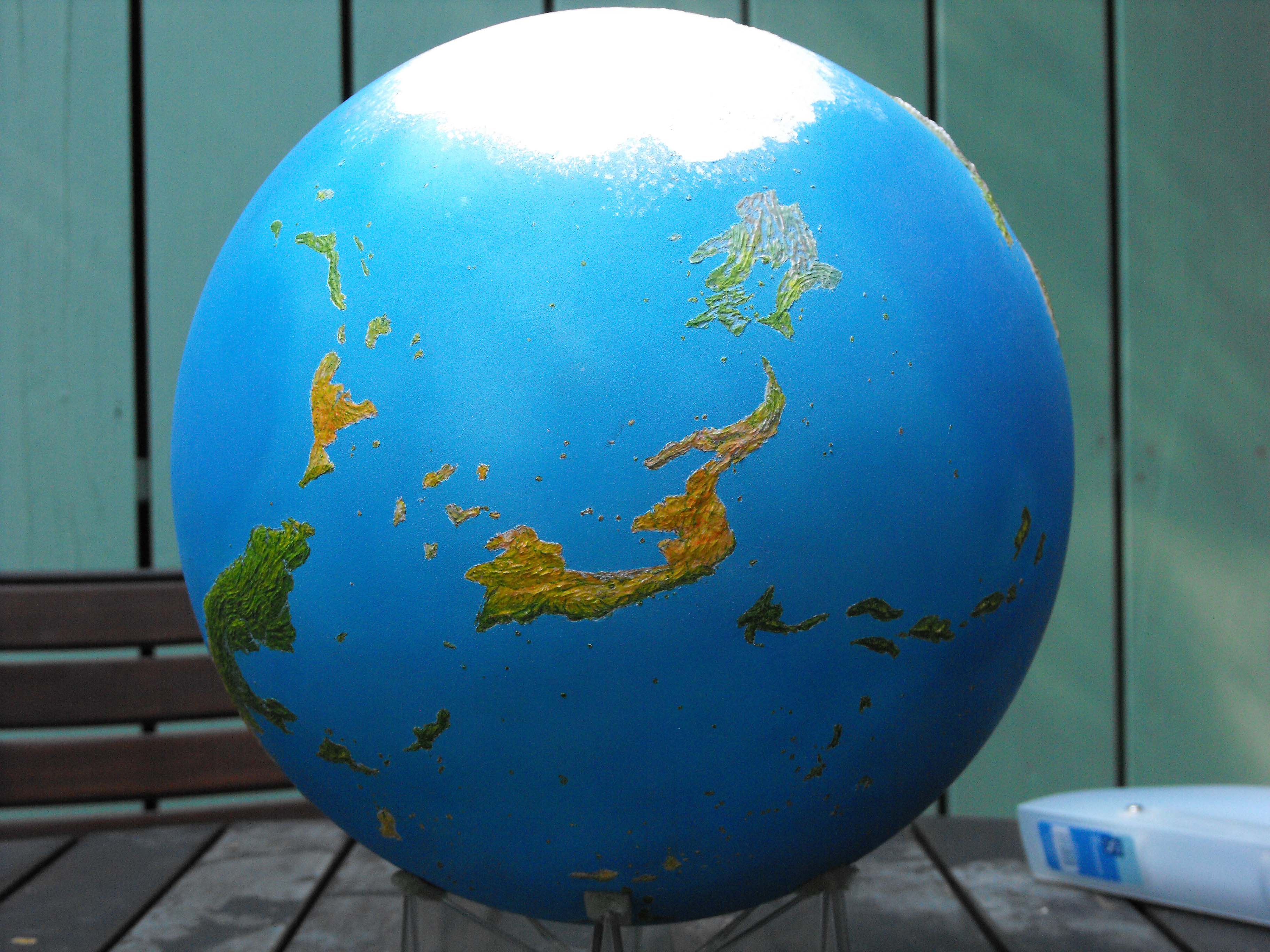
Silted Seas
The deep ocean basins that were are now extensively filled with sediment eroded off the ancient continent. Seas are shallower on Planet 3 than on Earth, averaging ~1 km as opposed to 3.7 km. As mentioned above, this shallower gradient between land surface and sea floor makes the geography of shorelines very unstable. The sea bed, especially around the fringes of the Sunken Continent, is very rich in mineral and oil deposits. Ocean currents form a similar pattern to those on Earth and, even in the absence of a large satellite, are subject to substantial solar tides (90% higher than Earth's) because of Epona's greater proximity to the central star. The height of the tide therefore will not quite match our Spring tides but remains substantial.
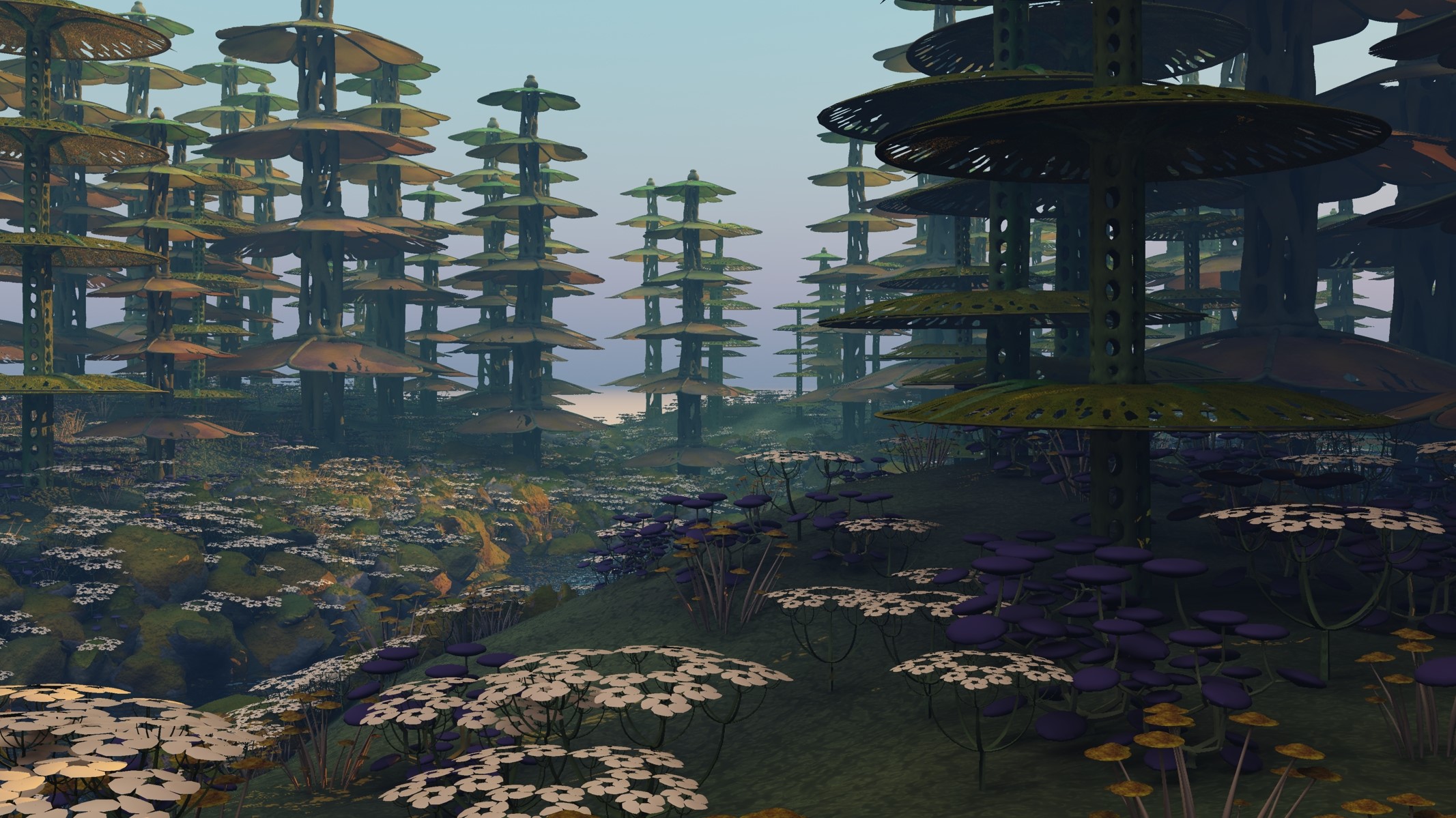
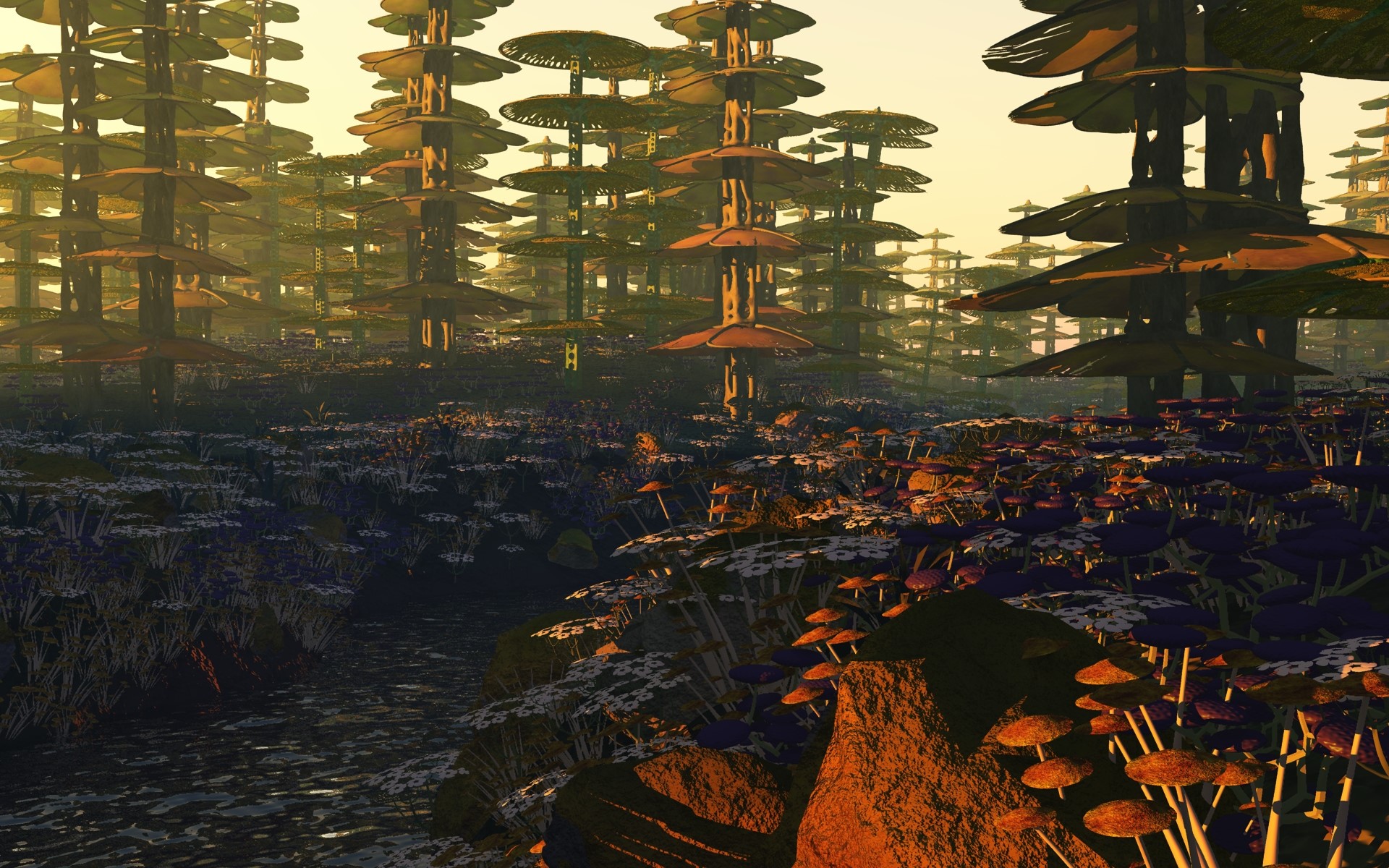
Polar Caps
The ice caps on Epona are bigger than on Earth, extending down almost to 60 degrees latitude. They only overlie land in the South-East. However, since the sea bed in places is so shallow, the ice is grounded on the bottom over a significant fraction of their area. This is why global sea level falls when the volume of ice at the poles increases and is gradually happening on Epona at the present time.
Atmosphere
Composition of the atmosphere is similar to that on Earth, with a slightly higher (but gradually waning) partial pressure of CO2 because of the temporarily increased volcanic activity. However its mass and surface pressure is only a little more than half the terrestrial value and this would have some climatic effects, as well as the biological ones alluded to in the previous Section.
The length of Epona's day is almost identical with Earth and so similar Coriolis forces give rise to similar atmospheric circulation patterns. However, average windspeeds are greater since a lesser amount of gas has to do the job of equator to pole heat transport. This is particularly accentuated in Northern Summer when 40 days or so of particularly violent winds might be expected. The shallow sloping coasts of the Sunken Continent might suffer particularly badly from storm surges at this time.
The thinner atmosphere will improve its clarity, making the sky a more deep-blue, like that seen from the window of an airplane. The quality of seeing for astronomy, especially in the Highlands, will be excellent. Water droplets, falling in the lower gravity, will stay suspended for longer and will grow to a larger size. Rainbows on Epona therefore will be particularly fine and long lasting.
Sunken Continent
A billion years ago, Epona had continents and ocean basins, built in a similar way to those on Earth. Such processes have now ceased and erosion has worn much of the original surface down close to sea level.
Gradients are very low and so shorelines are very sensitive to the global volume of sea water and uplift or sinking of blocks of crust. The flooding of the planet during the latest warm spell and the growth of new volcanic plateaus in the West has inundated these ancient cratons creating vast areas of low lying islands, mainly concentrated in the Eastern hemisphere between 50 degrees N and S. (Only the very largest ones are shown on the map). As the planet is cooling again with more ice forming at the poles, the area of the sunken continent above the waves is expanding. Within historical timescales, islands have joined together, "swamps" have become "forests" or "grasslands" etc. The climate is maritime, with plenty of warmth, wind and rain off the sea. Imagine a Pacific crowded with many more islands, a few of them of large size, and you've got the picture.
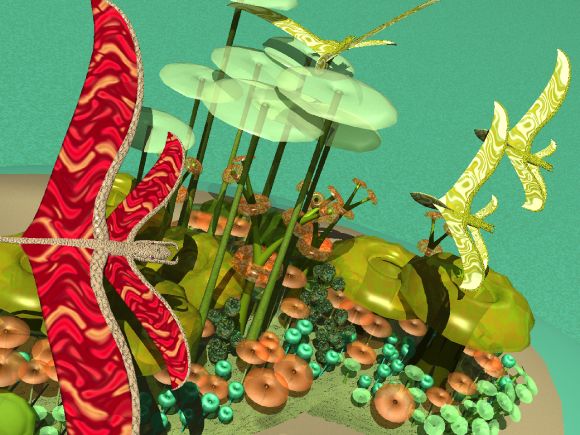
Highlands
These are the regions where terminal volcanism was or is still occurring; two adjacent Tharsis style bulges of great height (~10 km), between longitudes 40-140 degrees and crowned by large volcanoes. Whilst magmatic activity is on the wane, there are still occasional eruptions, emplacing fresh layers of lava. These large areas are roughly oval in shape and different in outline from the eroded ancient continents. They stand well above sea level and are the most noticeable features (barring the polar caps) when the planet is looked at from space. Most of the Highlands are habitable (except the high peak regions), with their interiors having a variety of continental-type climates. The Northern Highland has a particularly ferocious Summer and has the only large desert on Epona. The highest peak of all is situated on Fire Island, situated close to 0 degrees latitude, 0 degrees longitude. It is 11.5 km high and is still highly active. The magma being released on Fire Island is more viscous than from the main Highland volcanoes and thus slopes are steeper and the eruptions more explosive. Every century or so, a major eruption blasts so much ash into the stratosphere that the climate is noticeably affected (cooled) for several years.
Seasons
Epona has much stronger seasons than we are familiar on our home planet. Its 32 degrees spin axis is at a steeper angle than Earth's; we are accustomed here to 23 degrees 27'. However, we must also include the orbital eccentricity, which at 0.08 is much greater than that of Earth (0.0167) and almost as eccentric as Mars (0.0934). Thus at perihelion, Epona is at 0.717 AU with a solar constant 1.12 S (of Sol); at aphelion it is at 0.841 AU with a solar constant of 0.814 S (of Sol).
The shorter length of year, buffering in the planet's biosphere and the fact that most land is in the tropics, helps ameliorate these extremes, but they are significant nonetheless. For simplicity, we assume that the solstices coincide with the extremes of the orbit: i.e. Northern Summer is at perihelion and Northern Winter at aphelion. The orbital eccentricity will lead to substantial differences in length of these seasons. Thus the Southern hemisphere has long, mild summers and short, mild winters; while the Northern hemisphere has short, hot summers and long, frigid winters - the worst extremes the planet has to offer. (Note that precession of the spin axis reverses this situation every 20,000 years or so.)
Since Epona has no large satellite, the inclination of its spin axis evolves chaotically between extremes of 0 - 60 degrees over timescales of a few million years. Thus, even when young, this world was still subject to long-term, as well as seasonal, variations in climate giving rise to occasional extremes when the poles received more annually-averaged insolation than the equator. However, we didn't worry about this additional complication: Epona's recent history has been characterized by axial inclinations of close to, or a little less, than the present value. Foretelling the seasons a few million years hence though is not possible.
Epona Construction Commentary
We received this letter from Paul Preuss on the subject of Coti Mundi's magnetic field:
"I have a query which I think should be forwarded to Martyn Fogg. His description of 82 Eridani III notes that it has 55% of Earth's mass and 85% of Earth's size (radius), and that, 'Its material constitution was similar, having a liquid iron core, rocky outer layers, and a watery surface.' My question concerns the core. Given a low mass, presumably pressure‑temperature curves do not permit a solid iron core, but I don't have the expertise to compute this. Also, I wonder how large the liquid iron core is (another way of asking how much iron the planet contains). Since there are no moons, the planet presumably was denied one source of Earth's copious supply of iron -- Earth's moon is generally thought to have resulted from the collision of a Mars‑sized object with the primitive Earth, which object, disintegrating, contributed much of its iron core to Earth's and its stony outer layers, mixed with matter from Earth, to build our moon.
If there is no solid core, it seems to me the magnetic field of Coti Mundi could be a very strong and stable dipole. Earth's magnetic field is presumably generated by vortices in the liquid core, but these must be spaced around the solid inner core, which may contribute to their complexity and instability. Without such a solid inner core, a single vortex could form along the spin axis of the planet.
But if there's not as much iron inside Coti Mundi to begin with, this could reduce the chance of a strong magnetic field. It has been suggested that magnetic fields are used by some organisms for foraging and navigation and may have larger effects over evolutionary time. Any guidance?"
 Martyn Fogg replies:
Martyn Fogg replies:
I must admit that planetary magnetism is one of the areas of planetology that I am most ignorant of. What I do know is that nobody else fully understands how planetary magnetic fields are generated, how the reversal mechanism works and why some fields seem to be weirdly tilted to their planet's spin axis. Presumably, Mars doesn't have a magnetic field because its core is solid and may be mostly troilite (FeS); Venus may have a liquid core but perhaps its slow rotation prevents the formation of the sort of currents that generate a magnetic field. Thus, for 82 Eridani III, I had to resort to "hand waving," reasoning that the planet has a rapid spin and probably a liquid core, and therefore it has a magnetic field. No more thought went into it than that I'm afraid.
Your hypothesis concerning the strength and stability of the planet's magnetic field is interesting, but I am not convinced. It may be instead that the presence of a solid center to the core may result in the liquid layer receiving shear forces from both above and below generating the flows that we require. Shear currents may not occur in a completely liquid core and, if its temperature gradient is adiabatic, there wouldn't be much convection either. (I vaguely remember talking to somebody who said this is why Venus has no field -- its core is completely liquid -- no shear. But I tried looking it up today and couldn't find anything.)
